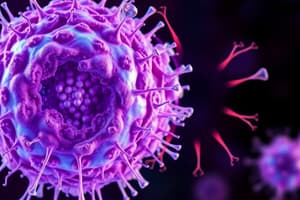Podcast
Questions and Answers
What key structure differentiates eukaryotic cells from prokaryotic cells?
What key structure differentiates eukaryotic cells from prokaryotic cells?
- Nucleus (correct)
- Ribosomes
- Plasma membrane
- Cell wall
What is the approximate size difference between prokaryotic and eukaryotic cells?
What is the approximate size difference between prokaryotic and eukaryotic cells?
- Prokaryotic cells are approximately 20x smaller
- Prokaryotic cells are approximately 10x smaller (correct)
- Prokaryotic cells are approximately 5x smaller
- Prokaryotic cells are approximately equal in size
Which structure is shared by both prokaryotic and eukaryotic cells?
Which structure is shared by both prokaryotic and eukaryotic cells?
- Nucleus
- Cytoskeleton
- Plasma membrane (correct)
- Membrane-bound organelles
Where is DNA located in prokaryotic cells?
Where is DNA located in prokaryotic cells?
Which statement about prokaryotic cells is correct?
Which statement about prokaryotic cells is correct?
Which of the following are characteristics of prokaryotic cells?
Which of the following are characteristics of prokaryotic cells?
What distinguishes eukaryotic cells from prokaryotic cells?
What distinguishes eukaryotic cells from prokaryotic cells?
In terms of cell complexity, how do prokaryotic cells compare to eukaryotic cells?
In terms of cell complexity, how do prokaryotic cells compare to eukaryotic cells?
Which of the following is NOT a component shared by both prokaryotic and eukaryotic cells?
Which of the following is NOT a component shared by both prokaryotic and eukaryotic cells?
Where is the DNA located in a prokaryotic cell?
Where is the DNA located in a prokaryotic cell?
Which option correctly describes the ribosomes in prokaryotic cells?
Which option correctly describes the ribosomes in prokaryotic cells?
Which of the following statements about eukaryotic cells is TRUE?
Which of the following statements about eukaryotic cells is TRUE?
What is the primary function of organelles within a eukaryotic cell?
What is the primary function of organelles within a eukaryotic cell?
Flashcards
Prokaryotic Cell
Prokaryotic Cell
A single-celled organism that lacks a membrane-bound nucleus and other organelles. Examples include bacteria and archaea.
Eukaryotic Cell
Eukaryotic Cell
A cell that has a membrane-bound nucleus and other organelles. Examples include plant, animal, fungal and protist cells.
Organelle
Organelle
A tiny structure within a cell that performs a specific function. Examples include mitochondria, ribosomes, and Golgi apparatus.
DNA
DNA
Signup and view all the flashcards
Cell Wall
Cell Wall
Signup and view all the flashcards
Cytoplasm
Cytoplasm
Signup and view all the flashcards
DNA (Deoxyribonucleic Acid)
DNA (Deoxyribonucleic Acid)
Signup and view all the flashcards
Ribosomes
Ribosomes
Signup and view all the flashcards
Nucleus
Nucleus
Signup and view all the flashcards
Nucleoid
Nucleoid
Signup and view all the flashcards
Study Notes
Prokaryotes vs. Eukaryotes
- Prokaryotic and eukaryotic cells are the two main cell types
- Both cell types share four common components: plasma membrane, cytoplasm, DNA, and ribosomes
- Prokaryotic cells are small and simple, lacking a nucleus and membrane-bound organelles
- Eukaryotic cells contain a nucleus and may have organelles
- Prokaryotic cells are roughly 10 times smaller than eukaryotic cells
- Organelles are tiny organs with specific structures for carrying out cellular functions
- The nucleus contains the cell's genetic material in the form of DNA
Prokaryotic Cell Components
- Plasma membrane: outer covering separating the interior from the environment
- Cytoplasm: jelly-like region within the cell; holds other components
- DNA: the genetic material of the cell
- Ribosomes: particles that synthesize proteins
Prokaryotic Cell Structure
- Nucleoid: the region within the cell that contains the chromosomal DNA
- Capsule: outer covering (in some prokaryotes)
- Cell wall: (in some eukaryotes), an extra layer of protection
- Pili: short, hair-like appendages
- Flagellum: long, whip-like structure for movement
Eukaryotic Cell Components
- Membrane-bound nucleus: central cavity where genetic material is housed
- Membrane-bound organelles: compartments with specialized functions (e.g., mitochondria, chloroplasts)
- Multiple linear chromosomes: multiple linear DNA strands, unlike prokaryotic cells' single circular chromosomes
Additional Notes
- Eukaryotes include animals, plants, fungi, and protists
- Both prokaryotes and eukaryotes have ribosomes
- Eukaryotic cells are much larger and more complex than prokaryotic cells, which allows them to handle more specialized functions
Studying That Suits You
Use AI to generate personalized quizzes and flashcards to suit your learning preferences.




